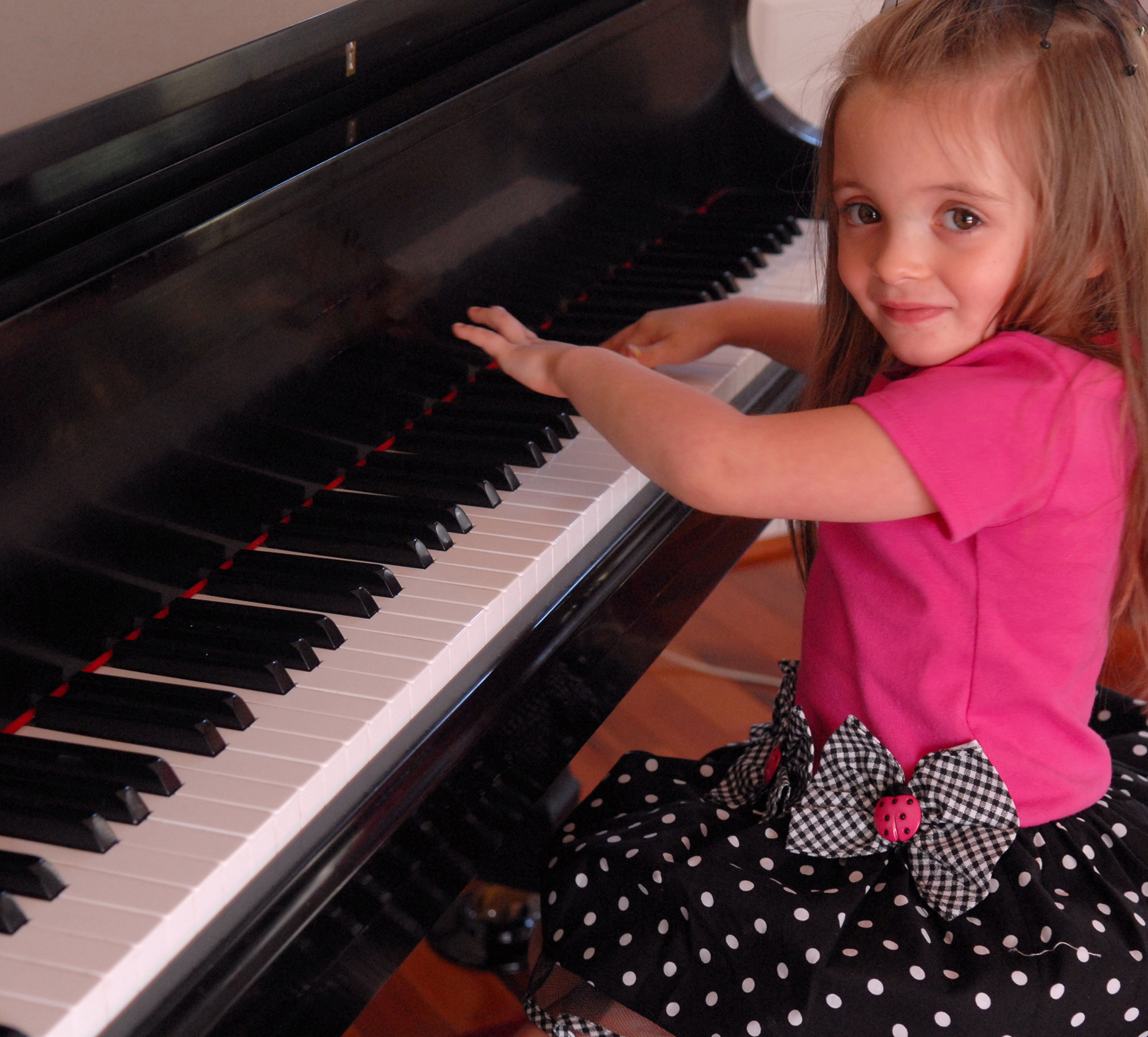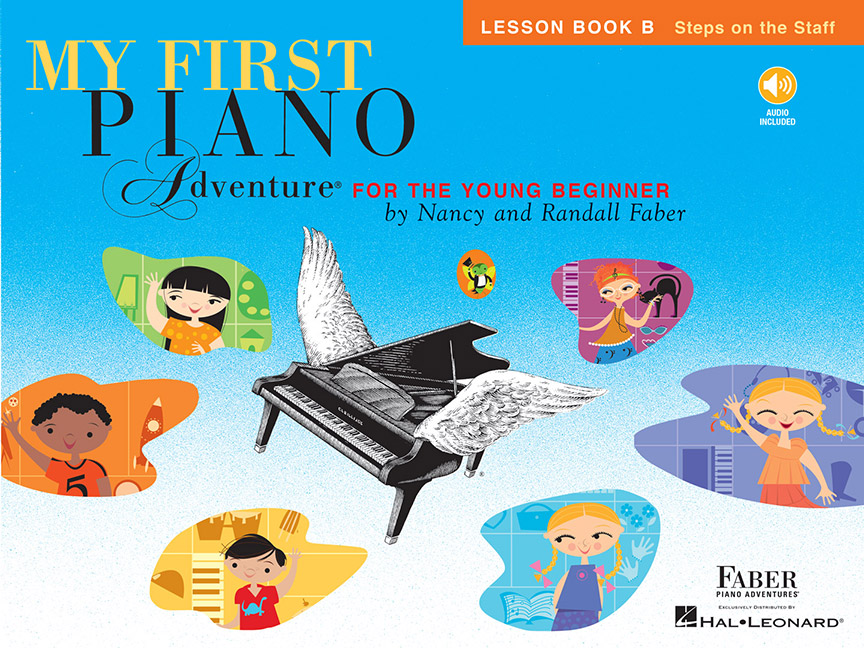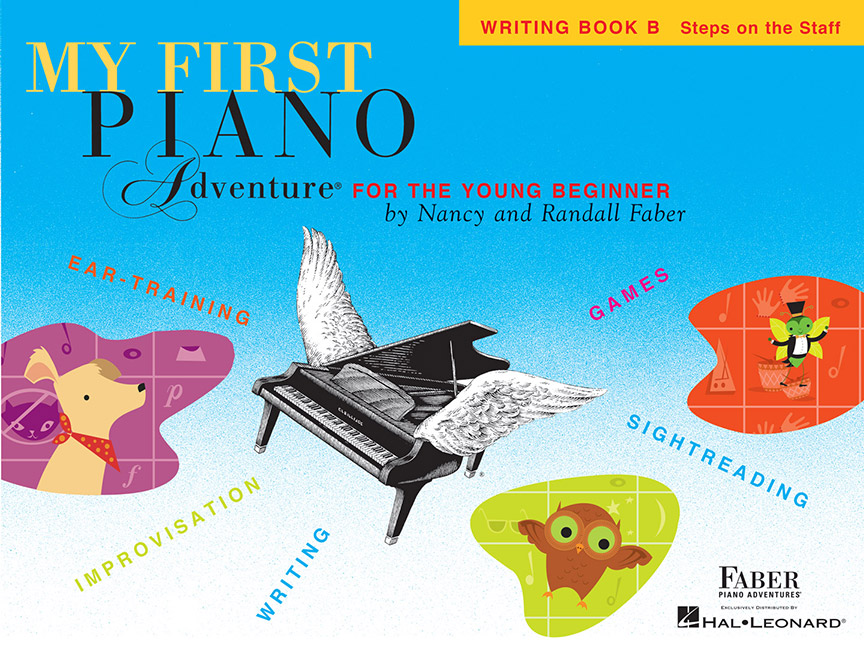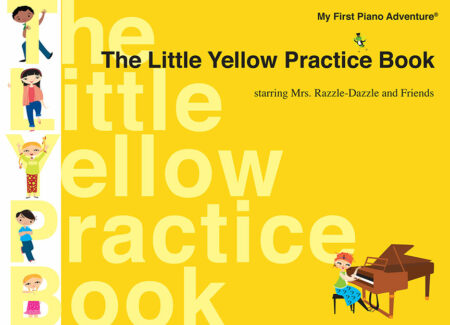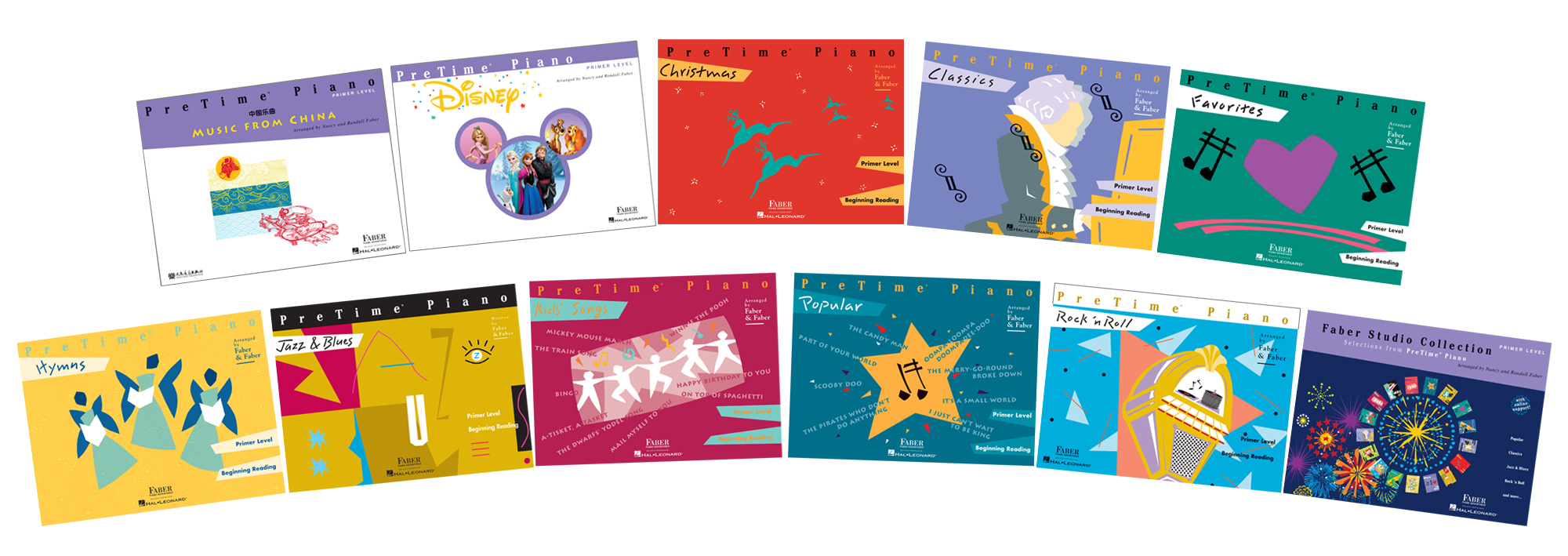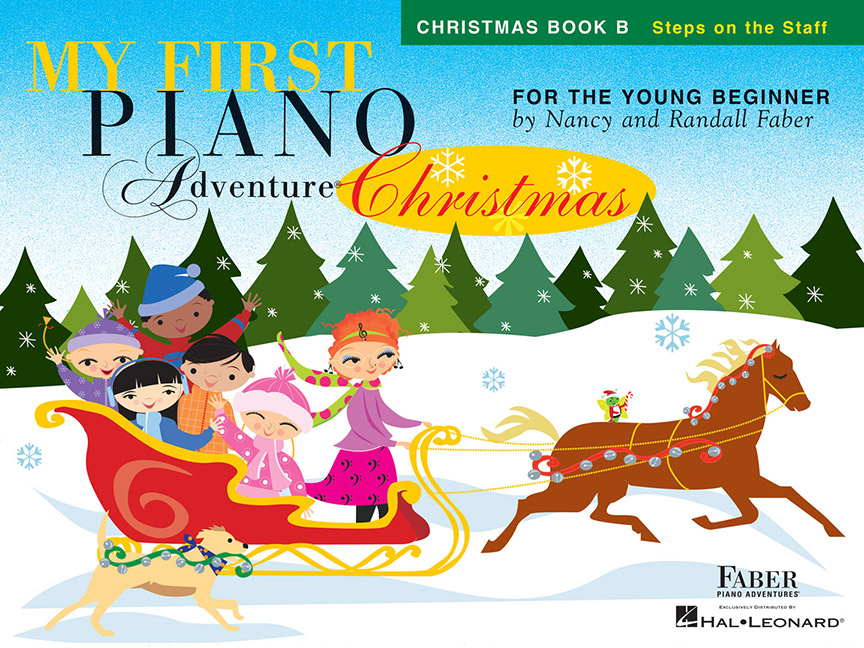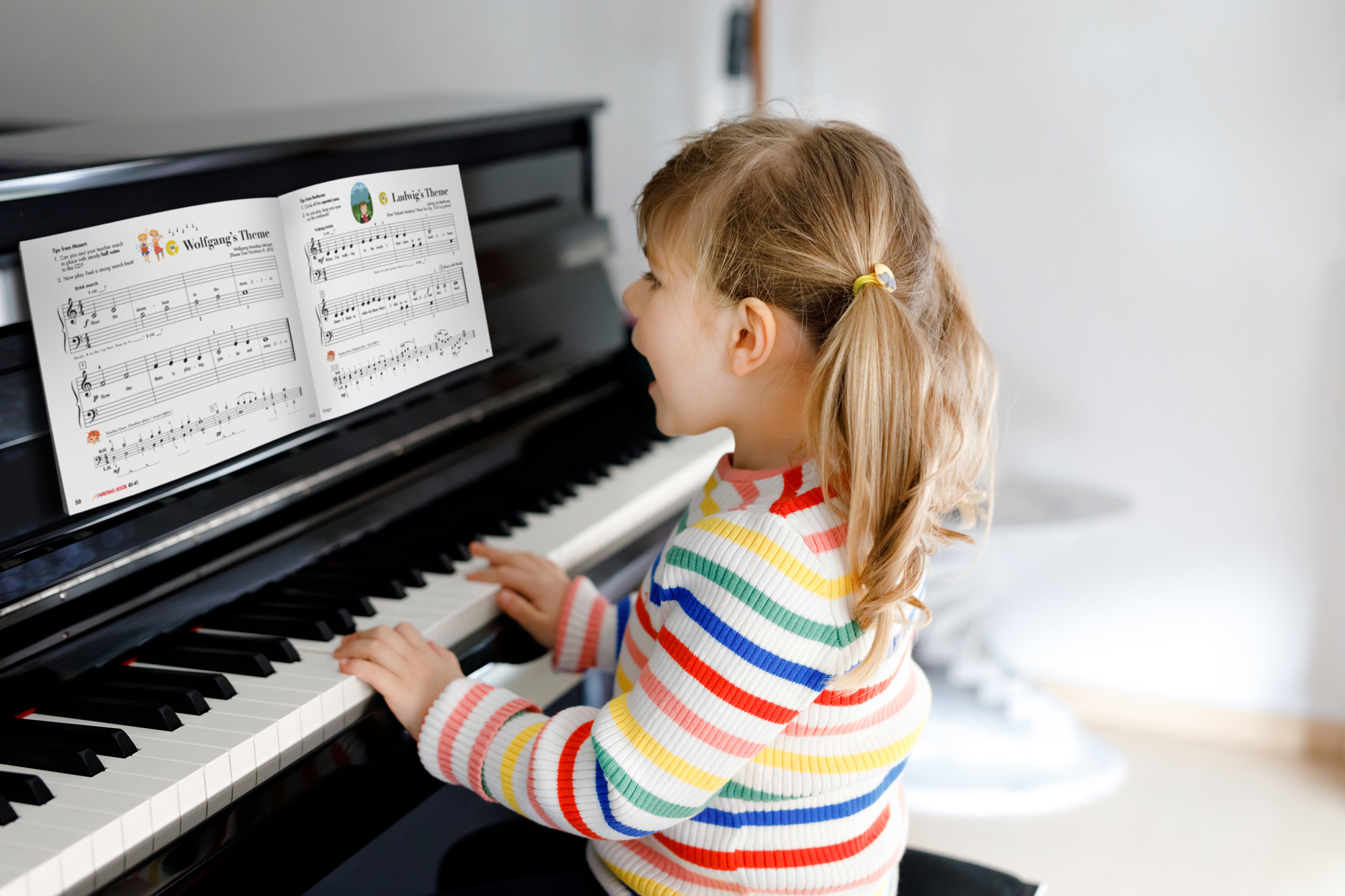
20Questions and Answers for My First Book B
- What is the main goal of Book B?
- What role do the “friends” play in Book B?
- Book B also features a CD /Audio of children singing each song. How important is this to the course?
- What is the reading strategy for Book B? Why are the lines numbered “inside to outside” on page 14?
- Is technique integrated into Book B?
- What kind of writing activities are in the B Book?
- Should a parent/caregiver attend the lessons?
- How long should a student in the “B Books” practice?
- How many songs should a teacher assign each week?
- Is it possible to teach online lessons with a Book B student?
- Is there a Teacher Manual for Book B?
- What other materials support teaching the B Books?
- Could a Book B student start a PreTime Book?
- How long should it take a student to complete the “B Books”?
- Is there a Christmas Book for the “B Level?”
- Can the “B Books” be taught in a group setting? Is an assistant needed?
- What if a student is not learning to read the notes well?
- What is the role of creativity in the “B Books”?
- Should a student memorize the assigned pieces?
- Could a student in the “B Books” play in a recital?
The description on the cover of Lesson Book B and Writing Book B says, “Steps on the Staff.” This is a quick summary of the main goal of the B Books: to read steps on the Grand Staff. This includes knowing the note names of those steps and playing the “stepping songs” with accurate rhythm. Reading steps on the staff is balanced with building technique. And why not build technique with melodies of Mozart and Beethoven, along with folk tunes and Faber originals.
Lesson Book B
Friends at the Piano (pp. 4-5)

By the end of Book B students are prepared to read skips on the staff and meet new composers, Haydn, Brahms, and Tchaikovsky, in the C Books.
2. What role do the “friends” play in Book B?
In the B Books the 5 “friends at the piano” learn to read music on the Grand Staff and meet composers, Mozart and Beethoven. The “friends” appear with new Technique Games and improvise with a five-note rock,” to name just a few activities.
As in the A Books, look for the “friends” to be part of presenting new concepts, ear-training, sightreading, and the Music Dictionary at the end of the book.
Lesson Book B
Music Dictionary (pp. 86-87)

One of the special features of the series is the artwork. Teachers can comment on the art with the student to engage a “musical conversation.” This draws the student into the page for a more personalized experience.
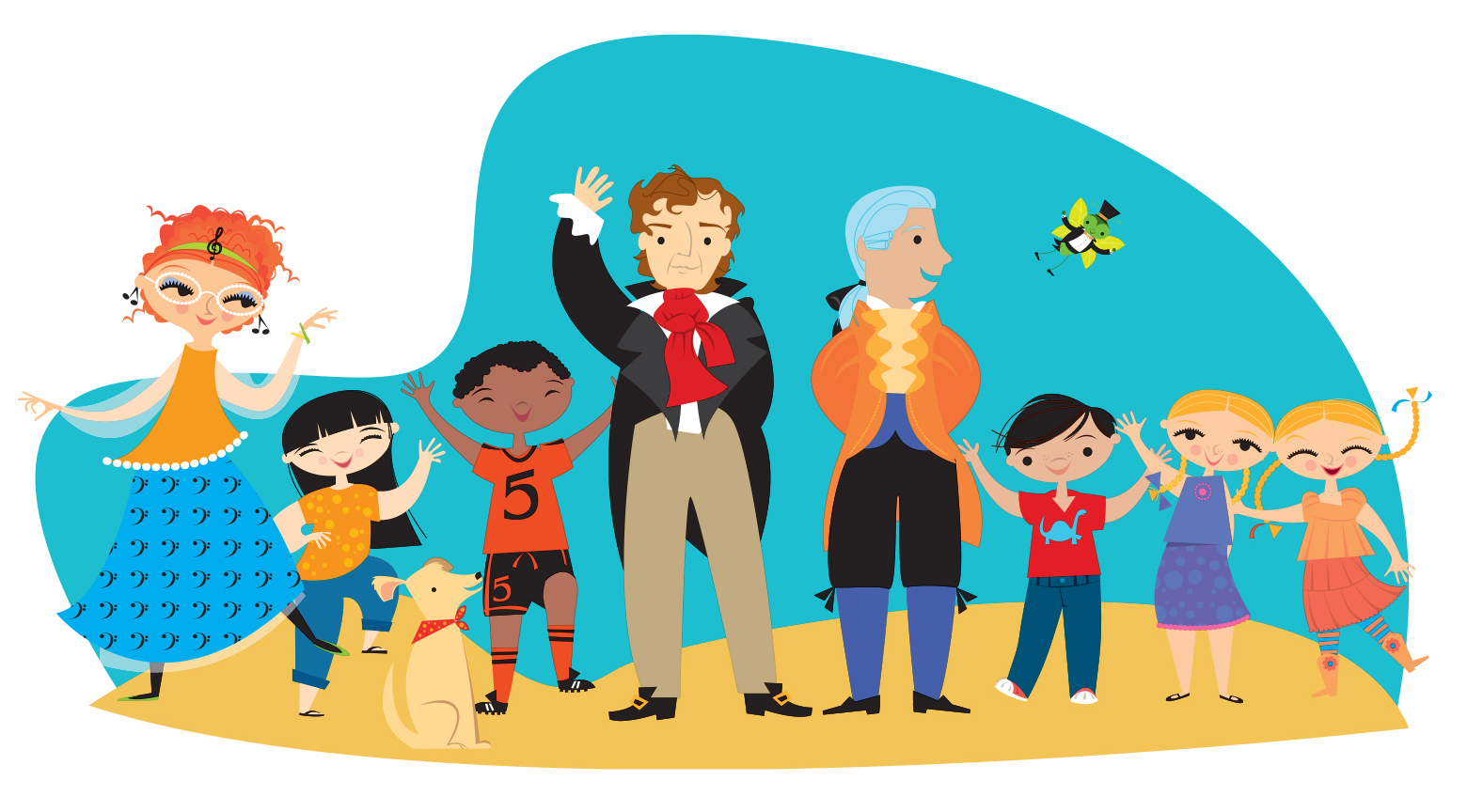
3. Book B also features a CD /Audio of children singing each song. How important is this to the course?
The Audio/CD is an essential component for the Lesson Book B in two ways:
- Singing is a fundamental activity in developing aural awareness. Recordings of children singing the songs encourage young piano students to sing along, too.
- The orchestrations introduce tempo, character, and colorful harmonies that expand the child’s aural world.
Here are a few ways to use the Book B Audio/CD:
- The teacher plays the orchestration for a song at the lesson.
To start, just listen. Listening prepares the child to hear patterns first, then see these patterns on the Grand Staff. - Play the orchestration again. This time the teacher and student point to the notes in rhythm with the music.
Sample a few audio songs.
Lesson Book B
Friends at the Piano (pp. 4-5)

Octave Blues (p. 67)
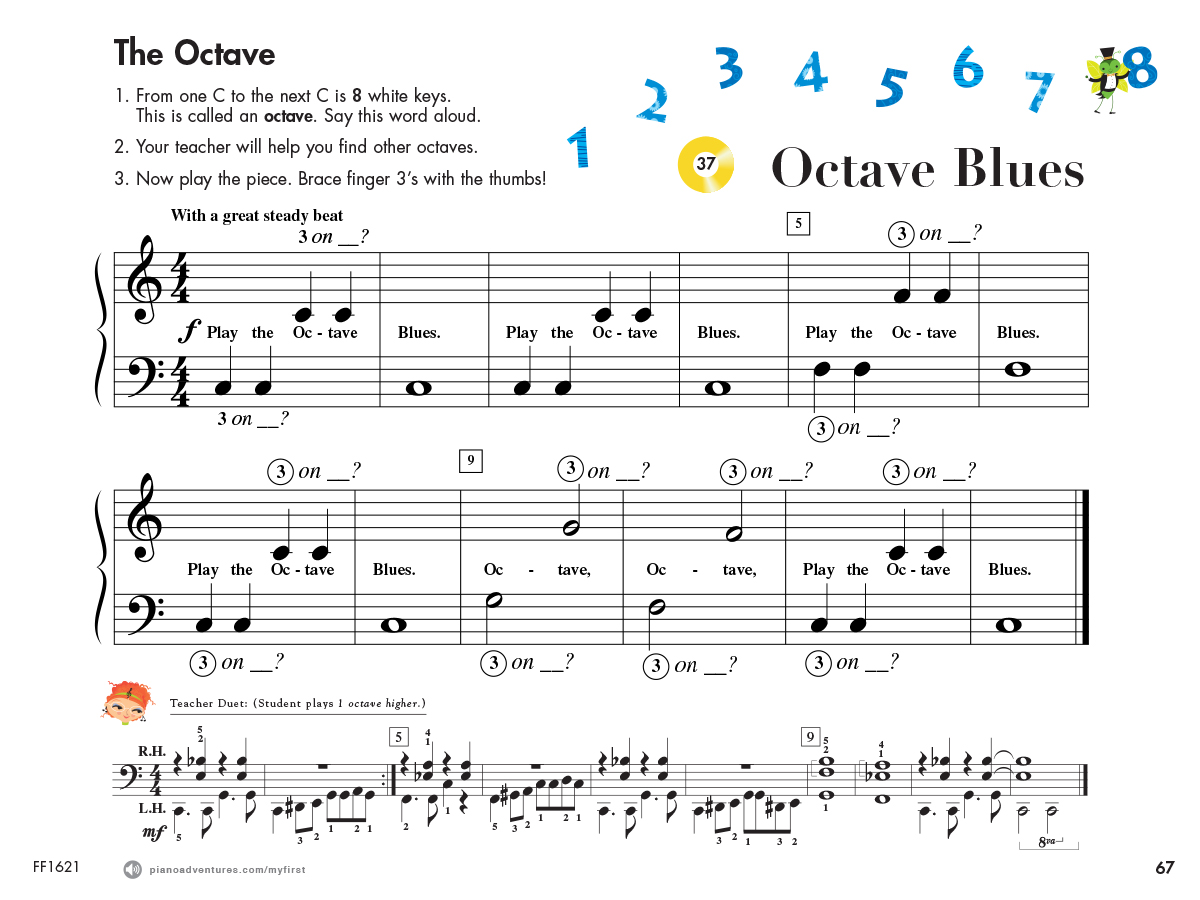
Twinkle, Twinkle Little Star (pp. 82-83)


4. What is the reading strategy for Book B? Why are the lines numbered “inside to outside” on page 14?
The reading strategy of the B Books covers a broad and also specific approach.
- First, to present the Grand Staff as a big, musical structure on which the notes travel.
- Second, to incrementally present notes that step up and down on the Grand Staff.
Students see the entire Grand Staff on pp. 14-15. They see that the music alphabet (A-B-C-D-E-F-G) can be written 3 times up the Grand Staff. Students color notes to show steps going up the staff; line-space-line-space.
Lesson Book B
The Grand Staff (pp. 14-15)

Notice that the lines and spaces on “The Grand Staff” (p.14) are numbered “inside out.” The reason for this is the young child’s small visual field. The child’s eyes naturally go to the center of the Grand Staff. Accordingly, notes are shown from Middle C stepping up (C-D-E-F-G) and Middle C stepping down (C-B-A-G-F). This immediately gives over an octave range (Bass F up to Treble G) for beautiful melodies shared between the hands.
This strategy creates a reading field using a confined set of notes that change fingering within that set of notes. It develops a technical field by allowing the child to focus on a round hand shape and firm fingertips. And importantly, it offers an artistic field with the superior range of melodic content that can be presented to the young beginner.
Students begin learning notes incrementally so as not to overwhelm. But more than note names are taught. The concept of step is introduced and musical patterns. All pianists read by note names, intervals, and musical patterns. The B Book reading approach uses these 3 strategies from the start.
Here are sample pages that represent the reading progression.
Lesson Book B
The King’s Cat, The Queen’s Cat (pp. 16-17)

Pumpkin Party (pp. 22-23)

Gallop, Pony (pp. 38-39)
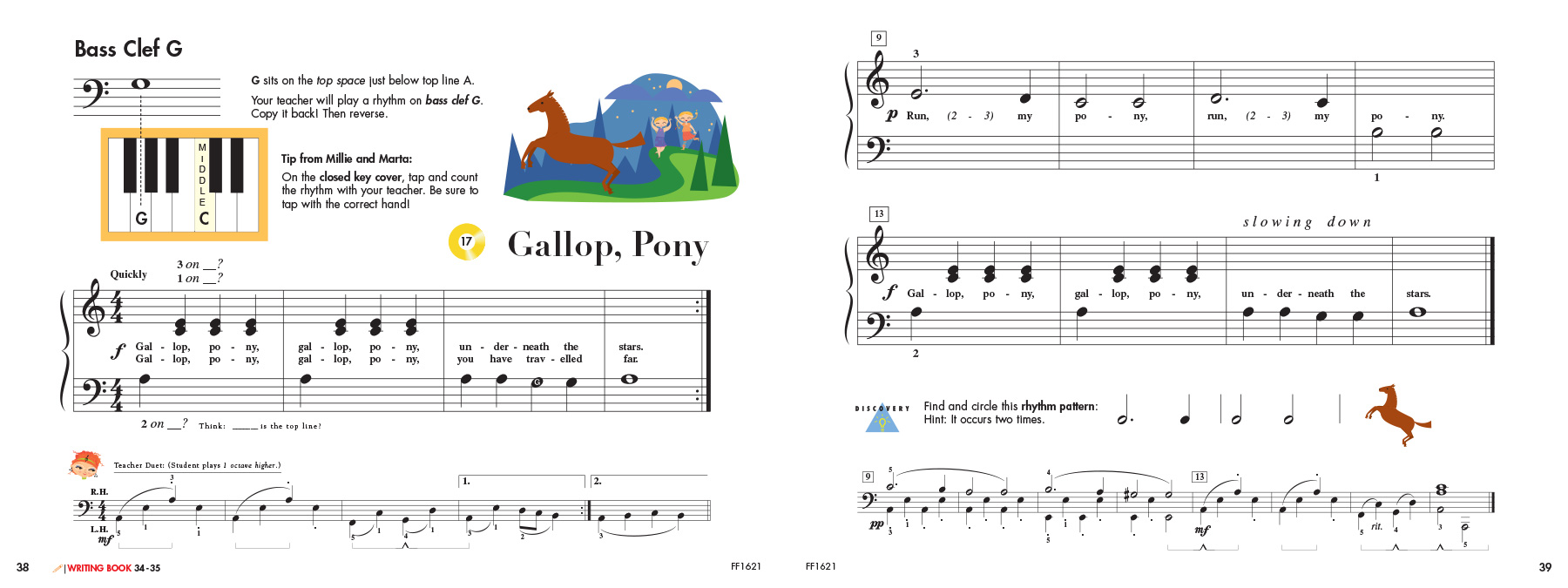
This Is My C Scale (pp. 68-69)

5. Is technique integrated into Book B?
Yes, technique is included in the Lesson Book B with Technique Games.
For the young beginner, we can use playful technique activities that guide small hand development. It’s been said that a child will never “grow” a pianistic hand. Technique from early lessons sets the stage for future artistry.
Here are a few samples of Book B technique activities:
Lesson Book B
Ode to Joy (p. 12)

Mozart’s Musical Patterns (pp. 24-25)

On My Two-Wheeler (pp. 52-53)

Construction Zone (p. 64)

6. What kind of writing activities are in the B Book?
Writing activities in the B Books involve finding steps, circling matching rhythm patterns, drawing bar lines, writing time signatures, and drawing various notes.
Here are sample pages.
Writing Book B
(p. 19)

A-B-C-D-E Rock! (p. 27)

Long May They Wave! (p. 29)

Escape of the Quarter Notes (p. 32)
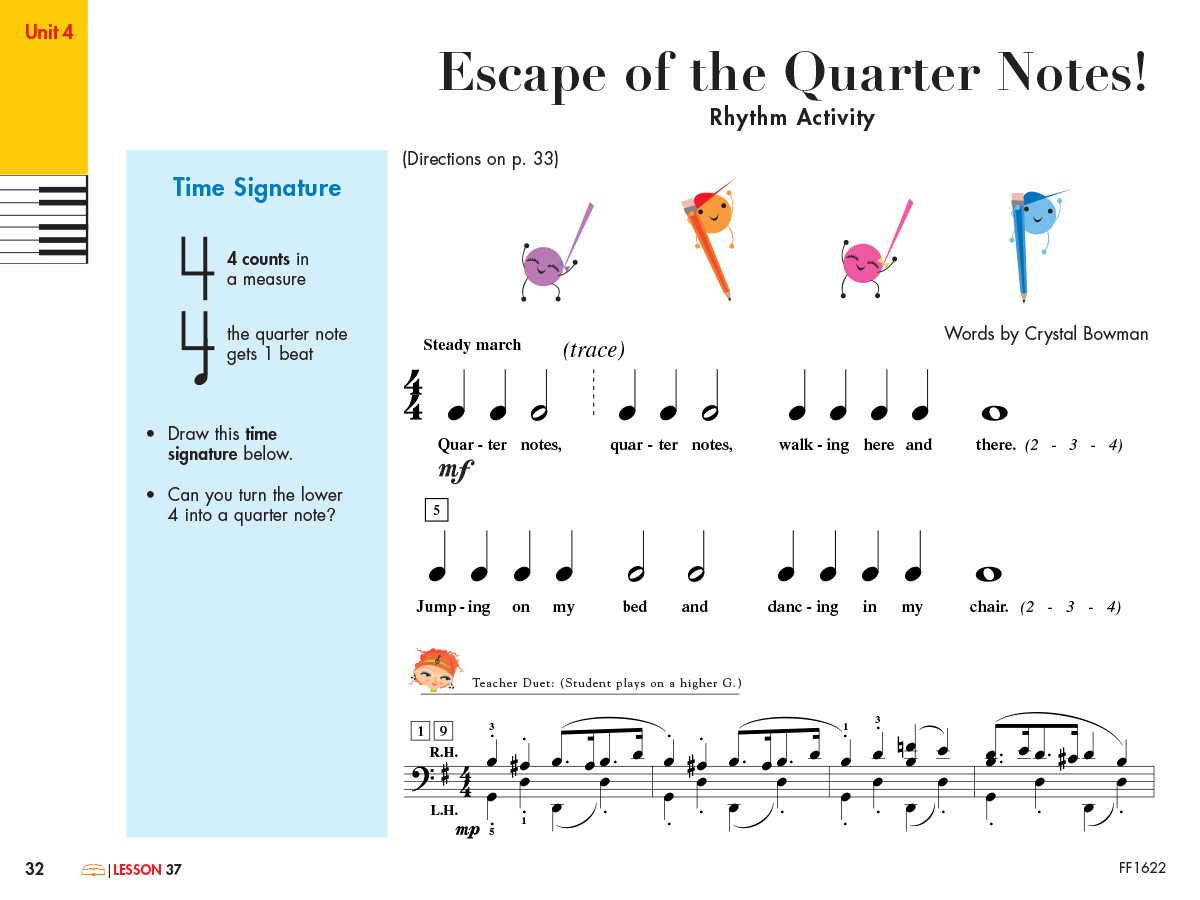
Rhythm Fun (p. 37)

1-2-3, The Pearl is in the Sea (p. 49)
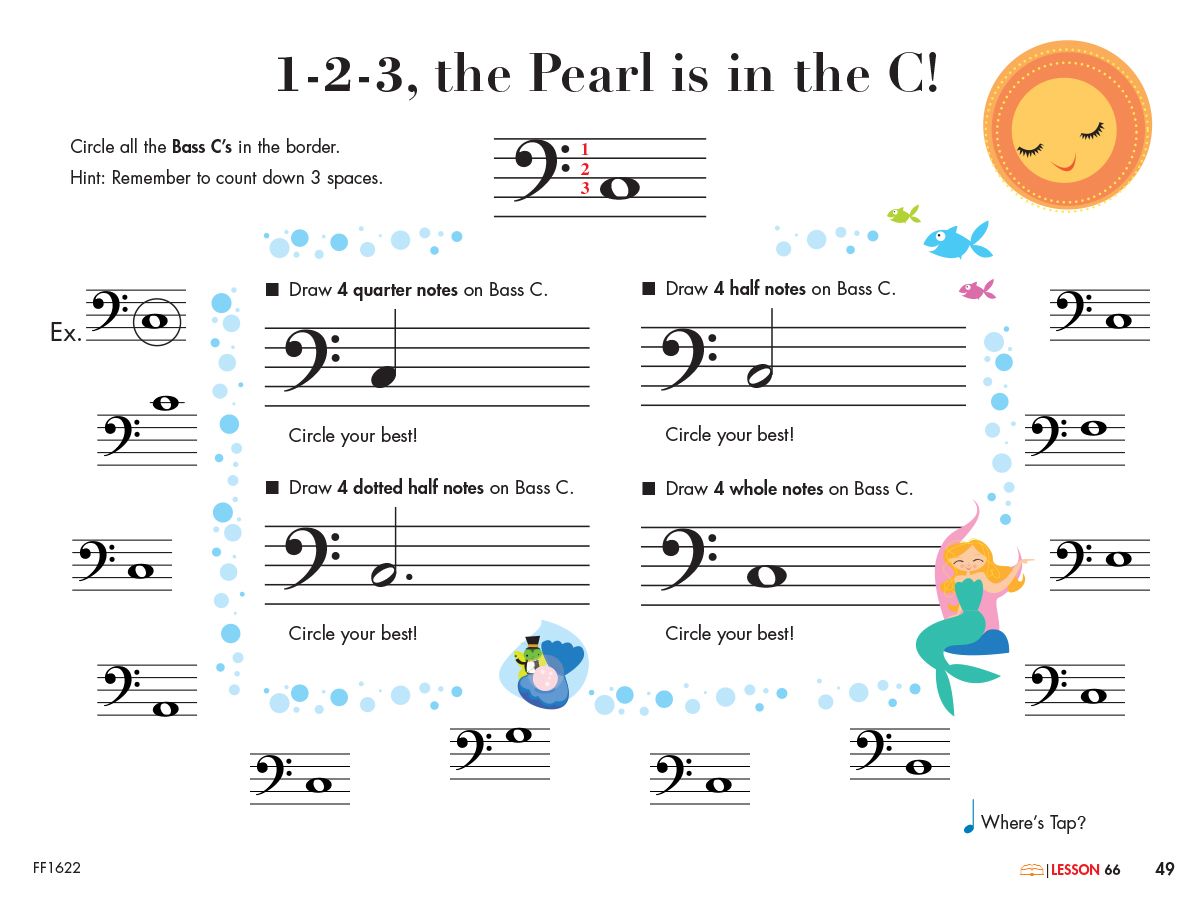
CLAP for Sightreading (p. 51)

7. Should a parent/caregiver attend the lessons?
For the “B Books,” most teachers welcome the parent/caregiver at the lesson. The parent gives a sense of security and the teacher may even work in opportunities for the parent to participate. Some parents choose to video parts of the lesson as a practice aid.
A good solution at Book B, if the student has already completed Book A, is for the parent to attend a lesson occasionally. The student is proud to “show and tell” what they have learned.
The teacher and parent can best determine how to proceed. Overall, having the parent attend some lessons brings:
- a renewed sense of the importance of lessons.
- a closeness between parent and child through the joy of music.
- a chance for the parent to learn music through the child’s eyes.
- an understanding of the assignment in case practice help is needed.
The parent may be a “practice guide” for the first day or several days of weekly practice. After that, see if the child would like to practice “solo” for the remainder of the week.
8. How long should a student in the “B Books” practice?
The old saying, “30 minutes of piano practice a day” may be good for higher levels. But it does not completely apply to the Book B student.
Most Book B students may practice for about 20 minutes a day. Sometimes more. These 20 minutes can even break up into two 10-minute segments. The goal is for practice to be fun— improvement and confidence building each day!
A general rule of thumb is to assign the same number of pieces as the student’s age. If the student is six, assign 6 pieces. Two or three pieces can be new. Two pieces might be for review. One piece might be to play by memory! Introduce the idea of what practice means. Practice is repeating the song several times—maybe 3 to 5 times—with the goal that it sounds better and better and gets easier and easier!
We might tell students to ask themselves after they complete their practice: “Were my pieces easier today?” That’s a confidence booster.
The Little Yellow Practice Book is excellent for assignments. A keyboard allows students to color in each day of practice.
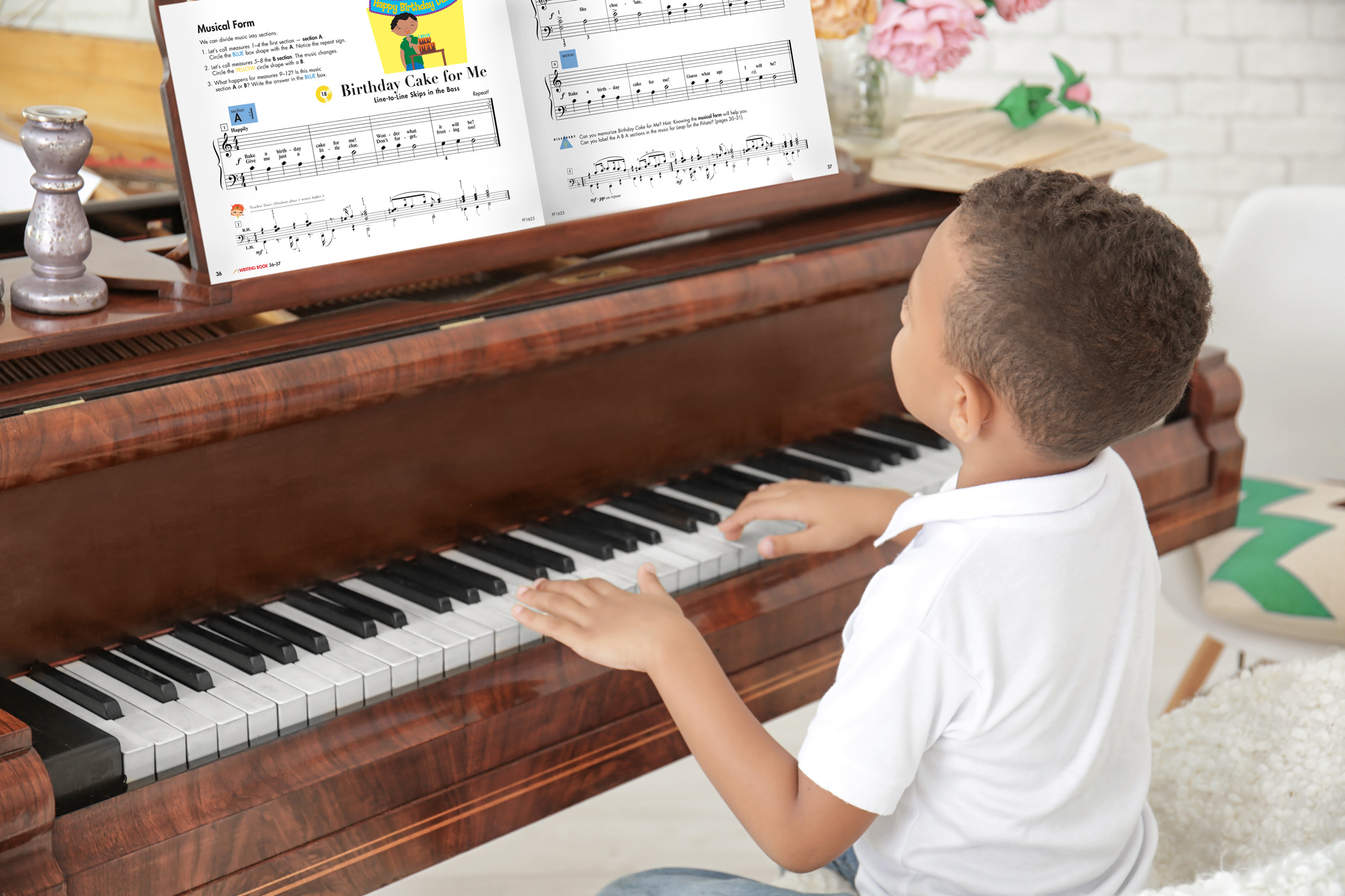
9. How many songs should a teacher assign each week?
In general, as noted above, teachers may consider assigning the same number of pieces as the student’s age. If the student is 6, assign 6 pieces. One or two pieces may be for review. One may be to play by memory!
If the student can do more and desires to do more, by all means expand the list.
Another extremely beneficial assignment, in lieu of assigning more pieces, is to keep listening to the CD/audio.
Many musical advantages take place:
- hearing different instruments in the orchestrations.
- hearing actual children’s voices as a model for singing.
- “unconsciously” forming a library of aural patterns—melodic and rhythmic.
- processing the music notation faster as a result of the aural foundation.
The Little Yellow Practice Book (p. 17)
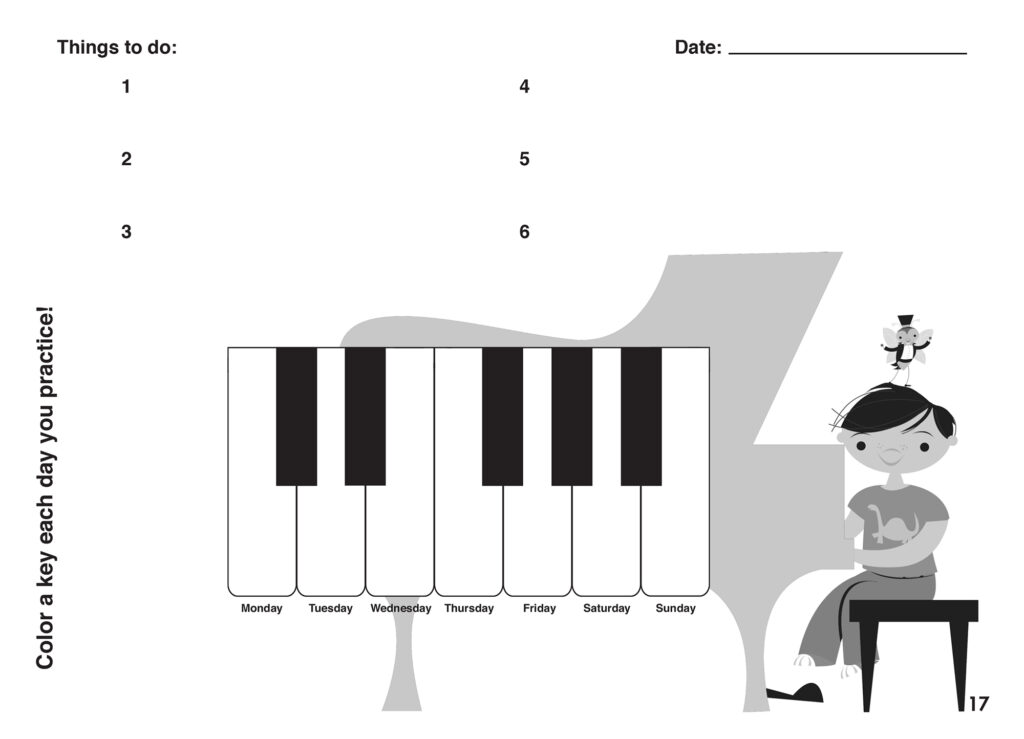
10. Is it possible to teach online lessons with a Book B student?
Yes, it is possible to teach Book B students in an online lesson, such as Zoom. It can, however, present some challenges due to the young age.
Five things will make online teaching easier:
- The teacher should subscribe to the Teacher Atlas so screen sharing is easy and quick!
- It may be helpful for the teacher, parent, and student to consider two 15-minute lessons a week. This can be more successful than a 30-minute lesson where the length of screen focus may be taxing for the child.
- Ideally, the parent would participate in the online lessons to help direct the student, find pages quickly, etc. And ideally, the parent will help the child practice, at least for the first several days of the new practice week.
- The teacher may use a question-and-answer format of “discover the song together” through screen sharing before playing the piece.
Let’s apply this to a first song, “The King’s Cat.” These are sample ideas. Teachers can create original questions and responses.
These are sample ideas. Teachers can create original questions and responses.
Lesson Book B
The King’s Cat (p. 16)
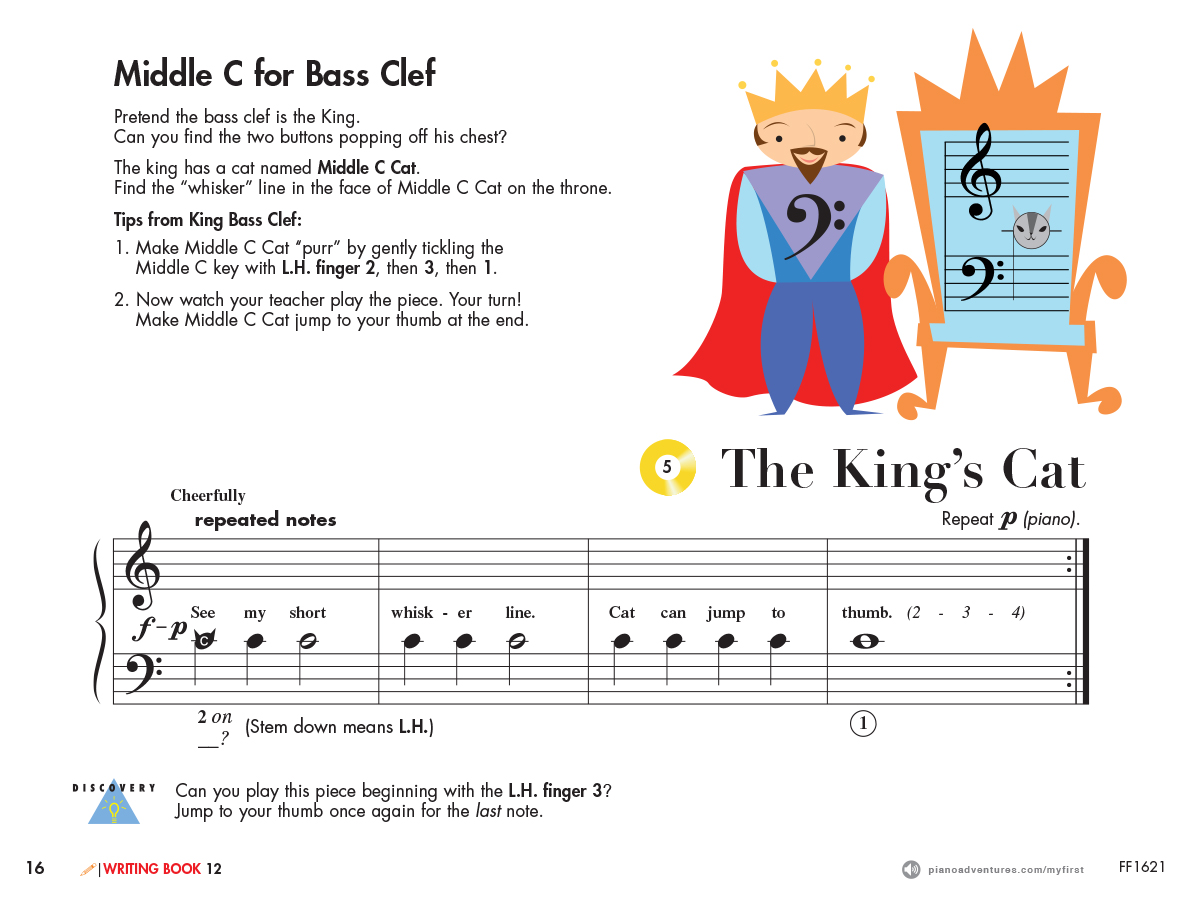
- (Screen Share On)
We have fun things to talk about with this piece. Let’s look at the king.
What color is his cape?
“Yes, red.”
How about his pants?
“Yes, the king likes blue.” - What is sitting right on top of his purple vest?
“Yes, a big bass clef.” - Can you find the two dots popping off his chest?
“Good. Remember those dots. They’re quite important!” - Look at his throne. There’s a cat face inside a note.
The king has a cat. The cat’s name is “Middle C Cat.” Can you say that?
“Good.”
Now look closely. Can you find the whisker line coming out of each side of his face?
“Very good. Now can you take your book and trace the line?”
(Parent or caregiver to help.) - Look at the Middle C note again. Is the stem going up or down?
“Correct, going down. That means it’s for the LH.
Can you raise your LH? “Good!” - This note with the whisker line is Middle C on the piano. I’m going to play Middle C. Can you find and play it, too?
“Excellent.” - Now watch my LH. I’m going to gently tickle the Middle C key with my LH finger 2 (Do), then I’m going to switch to finger 3 and tickle the key (Do) and then to my thumb (Do). (Parent to help.)
“Can you tickle Middle C with LH finger 2, then 3, then 1?
“Great! Try it again. Very good!” - Now let’s look at the music and listen to the recording. It’s going to be forte when the king sings and piano when the children sing. Let’s listen.
(Play the recording.)
“Did you notice the forte and piano sounds? Good listening!” - Now just a few questions before we play it.
Which measure has only quarter notes? “Good, measure 3.”
Which measure has a whole note? “Right, the last measure.”
Is the rhythm in m. 2 the same as m. 1? “Yes, the very same.” - Look below measure 1. Which finger starts?
“Good, finger 2.” - Move your eyes to the last measure. Do you see the circle around the 1?
That means we get to jump our hand to the thumb. Watch me play.
(Play, singing the words, and emphasizing the jump to the thumb.)
Your turn! Find Middle C with your LH finger 2.
“Very good! One time for the king and one more time for the cat.”
(Repeat) - Do you think you could play the piece with LH finger 3 and jump to the
thumb again? (Do)
“Great, you are an adventurer?” - Would you like to listen to the recording again or go on to the next song?
“Very good!”

11. Is there a Teacher Manual for Book B?
At this time there is no Teacher Manual for Book B. However, a teacher can use the concepts in this article, “spirit of play,” for lesson planning.
The acronym s.p.i.r.i.t is used as a child-centered guide to teaching and learning.
12. What other materials support teaching the B Books?
Teachers and students may also enjoy these support items for lessons:
Friends Posters

Flashcard Sheets Book

Flashcard Sheet 3

Flashcard Sheet 4

Flashcard Sheet 5
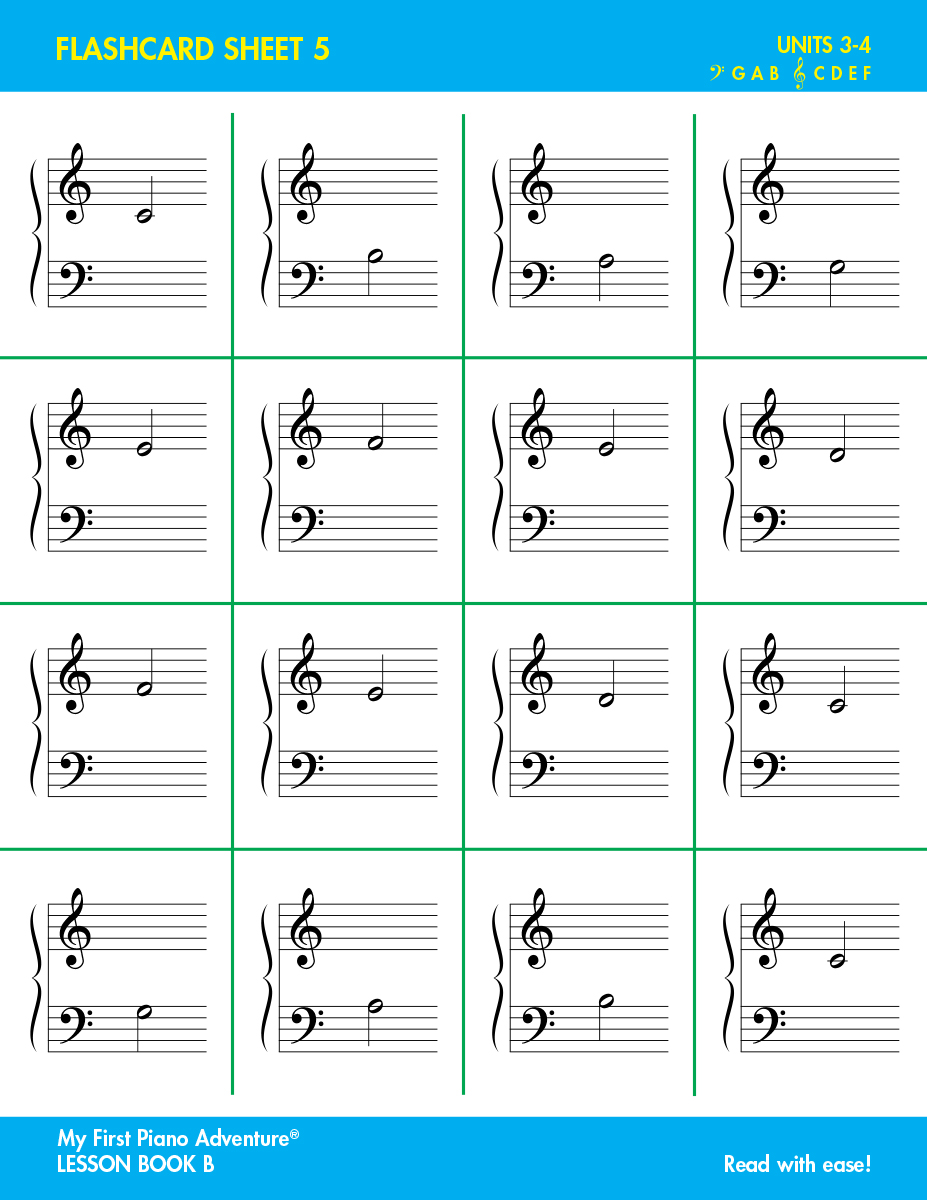
Flashcard Sheet 6

Flashcard Sheet 7

Flashcard Games and Activities

My First Piano Adventure Sticker Book


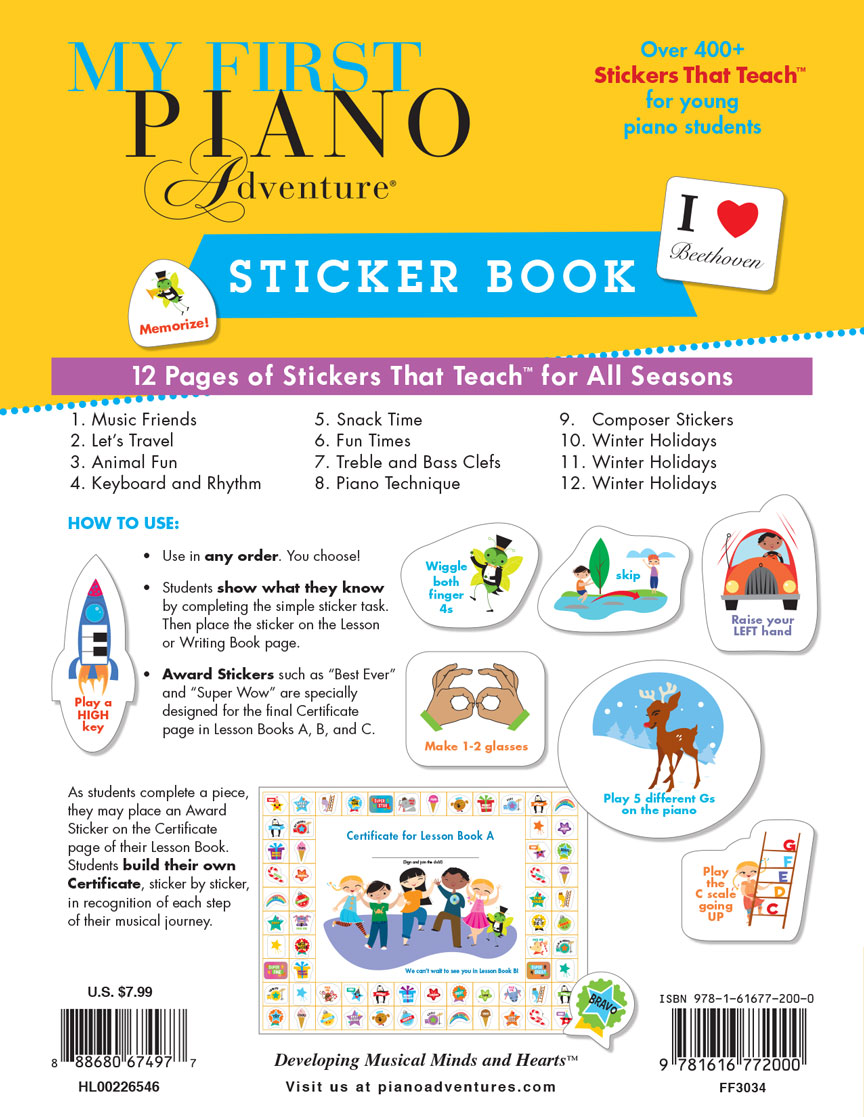
13. Could a Book B student start a PreTime Book?
Students who are ready for a challenge could explore a PreTime Book, although the PreTime Series is more suitable for Book C students. The best choice for leveling would be PreTime Favorites. Though there are occasional skips, a teacher could use a well-placed finger number and have the student write in the note name.
14. How long should it take a student to complete the “B Books”?
That is a good and open question. So much depends on the student, the teacher, and the length of the lesson. If a rough estimate were to be given, perhaps anywhere from 20-24 weeks. But this is just an estimate. Some students might finish sooner, some students may need the additional weeks for a more relaxed pace.
What is truly learned and enjoyed is the most important thing. Sometimes a little extra time in teacher-student communication, or the teacher’s own creative activity is just what is needed for a fun piano adventure!
15. Is there a Christmas Book for the “B Level?”
Yes, My First Christmas Book B is available! There are 8 pre-reading songs featuring colorful illustrations with the “friends.” A Christmas Music Calendar at the end of the book celebrates the season with music terms.
My First Christmas Book B
Jingle Bells (pp. 8-9)

Music Calendar (p. 20)

16. Can the “B Books” be taught in a group setting? Is an assistant needed?
Group piano lessons for Book B students is a great option. Four students is rather ideal but a larger class is possible, especially if an assistant is onboard. Some teachers might consider a Level 3B or 4 student to be an assistant!
- The CD/Audio is a valuable resource. Sitting in the Music Circle together, students can listen, tap, and follow the teacher’s motions. Fun, focused, and “community-centered.”
- A Writing Table is useful for working with pencil activities. (Giving each child the same color of crayon saves time.)
- At the end of each class, consider “Born to Perform” time. Each child plays a piece while the other students sit cross-legged on the floor being good listeners. At the end, a bow with claps from classmates begins forming stage etiquette and performing ease.
17. What if a student is not learning to read the notes well?
If a student is not learning to read notes well, there are fun things to do.
- See Question 12, and implement the Flashcard Sheets as a warm-up at the beginning of lessons. Consider asking the parents to purchase a set and play the games at home. This will go a long way in improving note reading!
- For new and review pieces, play a game of “My Turn, Your Turn.” For this, the teacher chants the notes in measure 1, the student in measure 2, the teacher in measure 3, and so forth. Chant the last measure together!
- Play a game of “Discover This!” where the student finds and names the highest note in the piece, the lowest note, the note that repeats the most.
All of these things, if done with regularity, will create a more confident, facile reader. And the teacher can create their own fun reading games!
18. What is the role of creativity in the “B Books”?
The entire My First Piano Adventures course has a creative flavor to it. Children travel imaginatively with the five friends who are also learning to play. Keyboard discovery is guided by Tap—the music firefly, Tucker—the dog who loves to listen (ear-training), and Blinker— the owl who loves to look (sightreading),
The Writing Book contains the improvising and composing activities. They all involve making musical choices, a key ingredient to create. Here are sample activities.
Writing Book B
How Do You Do, Mr. Beethoven? (p. 8)

The Queen Has Tea with Middle C Cat (p. 13)

A-B-C-D-E Rock! (p. 27)
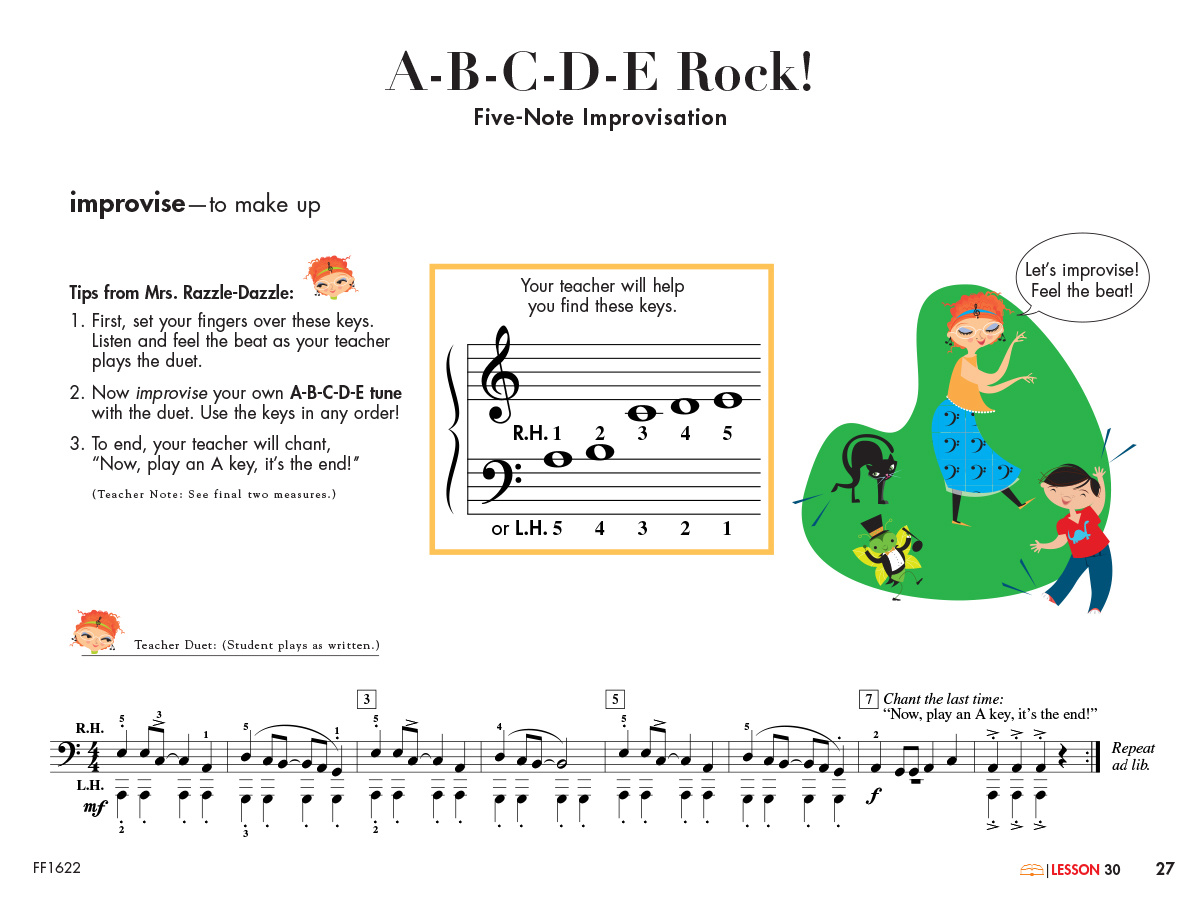
Bass C Groove (p. 48)

19. Should a student memorize the assigned pieces?
Book B pieces are short, often only 8 measures! Why not play one piece by memory each week, or every two weeks? Chat about the patterns. By starting early, as early as “Tub Time,” students integrate memorizing as a natural part of playing. With songs so short, they are immediately successful. And success breeds success!
Consider keeping a list of 3-4 pieces a student can play by memory at any time. Then when someone asks them to play, they are prepared to shine.
Lesson Book B
Tub Time (pp. 18-19)

20. Could a student in the “B Books” play in a recital?
Yes, a B Book student can most certainly play in a recital! Performing a song with the teacher duet can be ideal, offering support through a fun ensemble experience. Playing 2-3 favorite songs is also good so the time of sharing is not too brief. Some students enjoy playing with the orchestration at a recital.
Small recitals are recommended— a total of perhaps 10-12 students. The young beginner can enjoy other performances without becoming fatigued while waiting.
Consider giving students a “listening assignment.” Students can choose their favorite piece performed that they would like to learn. In this way the recital is not just about the student’s own performance, but also about listening to the music of others. And looking forward to the path ahead!
